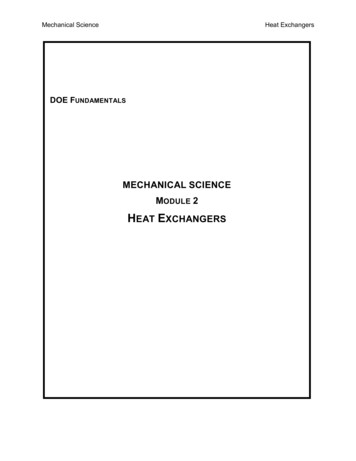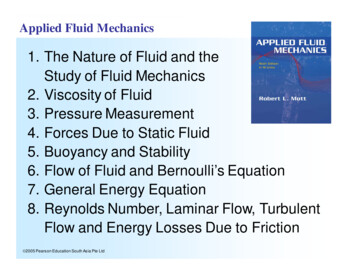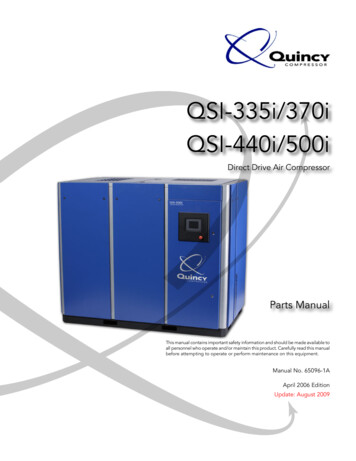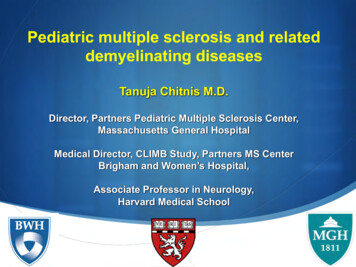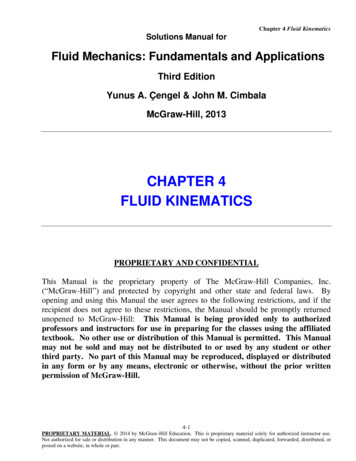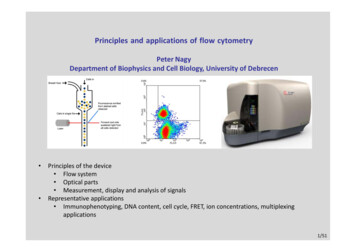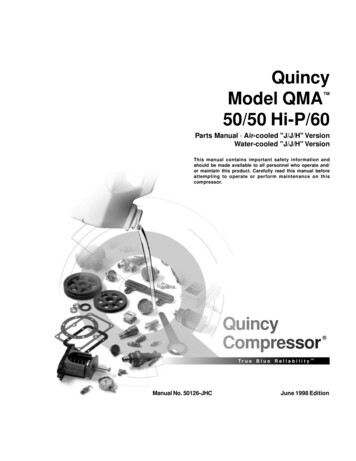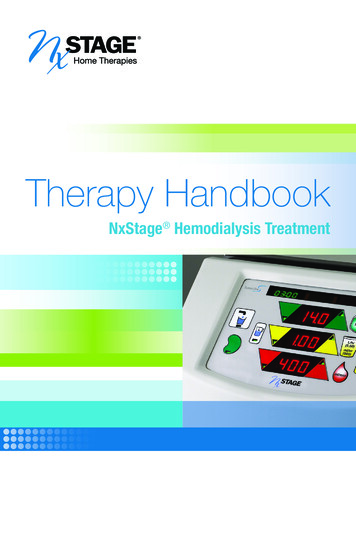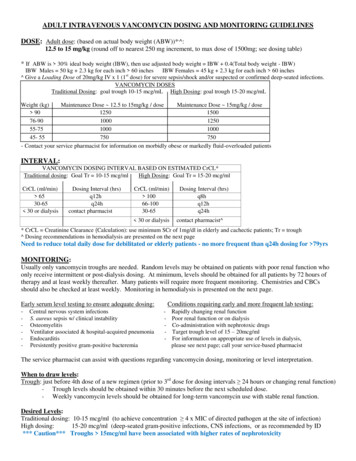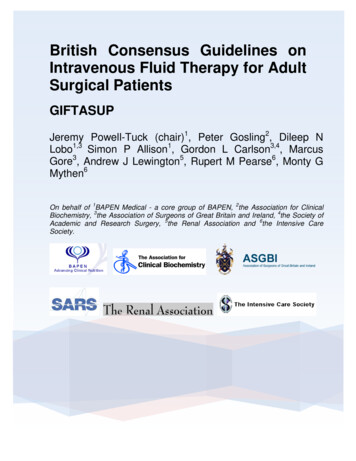
Transcription
British Consensus Guidelines onIntravenous Fluid Therapy for AdultSurgical PatientsGIFTASUPJeremy Powell-Tuck (chair)1, Peter Gosling2, Dileep NLobo1,3 Simon P Allison1, Gordon L Carlson3,4, MarcusGore3, Andrew J Lewington5, Rupert M Pearse6, Monty GMythen6On behalf of 1BAPEN Medical - a core group of BAPEN, 2the Association for ClinicalBiochemistry, 3the Association of Surgeons of Great Britain and Ireland, 4the Society ofAcademic and Research Surgery, 5the Renal Association and 6the Intensive CareSociety.1
With the involvement of and endorsement by:The British Association for Parenteral and Enteral Nutrition (BAPEN), theAssociation for Clinical Biochemistry, the Association of Surgeons of Great Britainand Ireland and Society of Academic and Research Surgery, the RenalAssociation and the Intensive Care Society.And the following individuals who have participated in the consensus process:Ravalia Abdulsatar, William Alazawi, Nawaf Al-Subaie, Charlotte Anderson, JanaBellin, Matthew Biggart, Harsha Boralessa, Tim Bowling, Christopher Chan,Michael Colley, Euan Dickson, Simon Eaton, MarinosElia, John Feehally, IanFellows, Simon Gabe, David Gore, Emma Greig, Richard Griffiths, Arpan Guhu,Mark Hamilton, Sura Hamoudi, Richard Hartopp, Anne Holdoway, Alan Jackson,Shaman Jhanji, Suren Kanagasundaram, Liza Keating, Andrew Kilner, FionaLeitch, Raz Mahroof, Jo Manson, Michael Margarson, Peter Mathieson, PeterMcQuillan, Telet Mumtaz, Thomas Mphanza, Ruth McKee, Penny Neild, NicholasLevy, Maria O'Donnell, Tim Palfreman, Kanthi Raveendran, Platon Raziz, KalpanaKrishna Reddy, Saxon Ridley, Brian Rowlands, Christine Russell, G. Samra,Sophia Sanibdeen, Charles Schmulian, Jon Shaffer, Debbie Shawcross, NicolaSimmonds, Mike Stroud, Clare Soulsby, Mo Thavasothy, Roger Townsend, TimTrebble, Bill Tunnicliffe, Martin Tweeddale, Howard Wakeling, Jagadeesh Waran,Tim Webb, David Welsh, Chris Willars, P. Vadgama, Kumaresh VenkatesanRevised 7 March 20112
3
Contents1. Summary and recommendations2. Introduction3. The Consensus Process4. Overview of normal sodium and water homeostasis5. Overview of fluid and electrolyte therapy in injury, illness andstarvation6. Assessment of fluid requirements7. Recommendations for preoperative fluid management8. Recommendations for intra operative fluid management9. Recommendations for postoperative fluid management10.Fluid management in acute kidney injury11.References12.Tables and FiguresI. Table 1: Typical properties of commonly used intravenoussolutionsII. Table 2: Assessment and monitoring of fluid balanceIII. Table 3: Composition of some bodily secretionsIV. Table 4: NICE criteria for nutritional supportV. Table 5: NICE Criteria for identifying patients at risk ofdeveloping refeeding problemsVI. Figure 1: body fluid compartmentsVII. Figure 2: Guidelines for fluid therapyVIII. Figure 3: Assessment of oliguria4
Summary and recommendationsFrom October 2006 the Association of Surgeons of Great Britain and Ireland,SARS, BAPEN Medical, the Intensive Care Society, the Association for ClinicalBiochemistry and the Renal Association nominated core members of a steeringcommittee who came together to establish consensus for good perioperative fluidprescribing. Concern arose from a high incidence of postoperative sodium andwater overload, and evidence to suggest that preventing or treating this, by moreaccurate fluid therapy, would improve outcome.The following recommendations are extracted from the complete document below.Members of the steering committee used the definitions of the Oxford Centre forEvidence-based Medicine Levels of Evidence (May 2001) accessed fromhttp://www.cebm.net/index.aspx?o 1025 to assign levels of evidence each ofwhich, after debate, was accepted unanimously.Distinction is made (a) between fluid and electrolytes required for normal existence(daily maintenance) and (b) for resuscitation or replacement of abnormal losses.No intravenous infusion should be continued simply because it is a “routine”component of clinical care. Food and fluids should be provided orally or enterallyand intravenous infusions discontinued as soon as possible.Prescribers need to understand the effects of surgical and metabolic stress on therenin-angiotensin-aldosterone system and on vasopressin elaboration. They musttake care to assess the patient’s sodium, chloride, potassium, and waterrequirements from a knowledge of the stress response and any current deficit orexcess; they must take into consideration normal maintenance requirements andthe expected composition of intestinal or other losses. Requirements thuscalculated are to be met based on a quantitative knowledge of the sodium, chlorideand potassium contents of the fluids prescribed. Prescription should not be madewithout such knowledge and no intravenous fluid should be regarded asintrinsically safe.Nutrition should be assessed and cautiously maintained. The oedematous patientshould be managed with particular care, in order to achieve successful negativesodium and water balance.Recommendation 1Because of the risk of inducing hyperchloraemic acidosis in routine practice, whencrystalloid resuscitation or replacement is indicated, balanced salt solutions e.g.Ringer’s lactate/acetate or Hartmann’s solution should replace 0.9% saline, exceptin cases of hypochloraemia e.g. from vomiting or gastric drainage.Evidence level 1b1-65
Recommendation 2Solutions such as 4%/0.18% dextrose/saline and 5% dextrose are importantsources of free water for maintenance, but should be used with caution asexcessive amounts may cause dangerous hyponatraemia, especially in childrenand the elderly. These solutions are not appropriate for resuscitation orreplacement therapy except in conditions of significant free water deficit e.g.diabetes insipidus.Evidence level 1b7-10Recommendation 3To meet maintenance requirements, adult patients should receive sodium 50-100mmol/day, potassium 40-80 mmol/day in 1.5-2.5 litres of water by the oral, enteralor parenteral route (or a combination of routes). Additional amounts should only begiven to correct deficit or continuing losses.Careful monitoring should be undertaken using clinical examination, fluid balancecharts, and regular weighing when possible.Evidence level 511Preoperative fluid managementRecommendation 4In patients without disorders of gastric emptying undergoing elective surgery clearnon-particulate oral fluids should not be withheld for more than two hours prior tothe induction of anaesthesia.Evidence level 1a12-14Recommendation 5In the absence of disorders of gastric emptying or diabetes, preoperativeadministration of carbohydrate rich beverages 2-3 h before induction ofanaesthesia may improve patient well being and facilitate recovery from surgery. Itshould be considered in the routine preoperative preparation for elective surgery.Evidence Level 2a15-19Recommendation 6Routine use of preoperative mechanical bowel preparation is not beneficial andmay complicate intra and postoperative management of fluid and electrolytebalance. Its use should therefore be avoided whenever possible.Evidence level 1a20-22Recommendation 7Where mechanical bowel preparation is used, fluid and electrolyte derangementscommonly occur and should be corrected by simultaneous intravenous fluidtherapy with Hartmann’s or Ringer-Lactate/acetate type solutions.Evidence level 56
Recommendation 8Excessive losses from gastric aspiration/vomiting should be treated preoperativelywith an appropriate crystalloid solution which includes an appropriate potassiumsupplement. Hypochloraemia is an indication for the use of 0.9% saline, withsufficient additions of potassium and care not to produce sodium overload. Lossesfrom diarrhoea/ileostomy/small bowel fistula/ileus/obstruction should be replacedvolume for volume with Hartmann’s or Ringer-Lactate/acetate type solutions.“Saline depletion,” for example due to excessive diuretic exposure, is bestmanaged with a balanced electrolyte solution such as Hartmann's.Evidence level 5 Consensus for the electrolyte content of secretions (Table III)based on Geigy Scientific Tables23Evidence level 2a for Hartmann’s versus 0.9% saline.1-6Recommendation 9In high risk surgical patients preoperative treatment with intravenous fluid andinotropes should be aimed at achieving predetermined goals for cardiac output andoxygen delivery as this may improve survival.Evidence level 1b24-27Recommendation 10Although currently logistically difficult in many centres, preoperative or operativehypovolaemia should be diagnosed by flow-based measurements whereverpossible. The clinical context should also be taken into account as this will providean important indication of whether hypovolaemia is possible or likely. When directflow measurements are not possible, hypovolaemia will be diagnosed clinically onthe basis of pulse, peripheral perfusion and capillary refill, venous (JVP/CVP)pressure and Glasgow Coma Scale together with acid-base and lactatemeasurements. A low urine output can be misleading and needs to be interpretedin the context of the patient’s cardiovascular parameters above.Diagnosis of hypovolaemia: Evidence level 1b28-35Recommendation 11Hypovolaemia due predominantly to blood loss should be treated with either abalanced crystalloid solution or a suitable colloid until packed red cells areavailable. Hypovolaemia due to severe inflammation such as infection, peritonitis,pancreatitis or burns should be treated with either a suitable colloid or a balancedcrystalloid.In either clinical scenario, care must be taken to administer sufficientbalanced crystalloid and colloid to normalise haemodynamic parameters andminimise overload. The ability of critically ill patients to excrete excess sodium andwater is compromised, placing them at risk of severe interstitial oedema. Theadministration of large volumes of colloid without sufficient free water (e.g. 5%dextrose) may precipitate a hyperoncotic state.Suitable colloid or crystalloid for hypovolaemia: Evidence level 1b36-44Administration of sufficient water: Manufacturers recommendations45,46: Evidencelevel 57
Recommendation 12When the diagnosis of hypovolaemia is in doubt and the central venous pressure isnot raised, the response to a bolus infusion of 200 ml of a suitable colloid orcrystalloid should be tested. The response should be assessed using the patient’scardiac output and stroke volume measured by flow-based technology if available.Alternatively, the clinical response may be monitored by measurement/estimationof the pulse, capillary refill, CVP and blood pressure before and 15 minutes afterreceiving the infusion. This procedure should be repeated until there is no furtherincrease in stroke volume and improvement in the clinical parameters.Evidence level for flow-based measurements: 1b47For bolus infusion: Evidence level 1b48Volume to be given: Evidence level 5 (consensus)For suitable colloid: Evidence level 1b36Intra operative fluid managementRecommendation 13In patients undergoing some forms of orthopaedic and abdominal surgery, intraoperative treatment with intravenous fluid to achieve an optimal value of strokevolume should be used where possible as this may reduce postoperativecomplication rates and duration of hospital stay.Orthopaedic surgery: Evidence level 1b28,33Abdominal surgery: Evidence level 1a30-32,34,48-50Recommendation 14Patients undergoing non-elective major abdominal or orthopaedic surgery shouldreceive intravenous fluid to achieve an optimal value of stroke volume during andfor the first eight hours after surgery. This may be supplemented by a low dosedopexamine infusion.Evidence level 1b24-27,50,51Postoperative fluid, and nutritional management.Recommendation 15Details of fluids administered must be clearly recorded and easily accessible.Evidence level 5Recommendation 16When patients leave theatre for the ward, HDU or ICU their volume status shouldbe assessed. The volume and type of fluids given perioperatively should bereviewed and compared with fluid losses in theatre including urine and insensiblelosses.Recommendation 17In patients who are euvolaemic and haemodynamically stable a return to oral fluidadministration should be achieved as soon as possible.8
Recommendation 18In patients requiring continuing i.v. maintenance fluids, these should be sodiumpoor and of low enough volume until the patient has returned their sodium and fluidbalance over the perioperative period to zero. When this has been achieved the i.v.fluid volume and content should be those required for daily maintenance andreplacement of any on-going additional losses.Recommendation 19The haemodynamic and fluid status of those patients who fail to excrete theirperioperative sodium load, and especially whose urine sodium concentration is 20mmol/L, should be reviewed.Evidence levels for recommendations 16,17,18 & 19: 1b2,7,52-59Recommendation 20In high risk patients undergoing major abdominal surgery, postoperative treatmentwith intravenous fluid and low dose dopexamine should be considered, in order toachieve a predetermined value for systemic oxygen delivery, as this may reducepostoperative complication rates and duration of hospital stay.Evidence level 1b34,51,60-62Recommendation 21In patients who are oedematous, hypovolaemia if present must be treated (as inSection 6g), followed by a gradual persistent negative sodium and water balancebased on urine sodium concentration or excretion. Plasma potassiumconcentration should be monitored and where necessary potassium intakeadjusted.Evidence level 1b2,7,53-59,63Recommendation 22Nutritionally depleted patients need cautious refeeding orally, enterally orparenterally, with feeds supplemented in potassium, phosphate and thiamine.Generally, and particularly if oedema is present, these feeds should be reduced inwater and sodium. Though refeeding syndrome is a risk, improved nutrition willhelp to restore normal partitioning of sodium, potassium and water between intraand extra-cellular spaces.Evidence level 5Recommendation 23Surgical patients should be nutritionally screened, and NICE guidelines forperioperative nutritional support adhered to. Care should be taken to mitigate risksof the refeeding syndrome.Evidence level 5: (NICE guidelines)649
Fluid management in acute kidney injury (AKI)Recommendation 24Based on current evidence, higher molecular weight hydroxyethyl starch(hetastarch and pentastarch MW 200 kDa) should be avoided in patients withsevere sepsis due to an increased risk of AKI.65-67Evidence level 1bRecommendation 25Higher molecular weight hydroxyethyl starch(hetastarch and pentastarch MW 200 kDa) should be avoided in brain-dead kidney donors due to reports of osmoticnephrosis-like lesions.66Evidence level 2bRecommendation 26Balanced electrolyte solutions containing potassium can be used cautiously inpatients with AKI closely monitored on HDU or ICU in preference to 0.9% saline. Iffree water is required 5% dextrose or dextrose saline should be used. Patientsdeveloping hyperkalaemia or progressive AKI should be switched to non potassiumcontaining crystalloid solutions such as 0.45% saline or 4%/0.18 dextrose/salineRinger’s lactate versus 0.9% saline for patients with AKI1Evidence level 1bRecommendation 27In patients with AKI fluid balance must be closely observed and fluid overloadavoided. In patients who show signs of refractory fluid overload, renal replacementtherapy should be considered early to mobilize interstitial oedema and correctextracellular electrolyte and acid base abnormalities.Evidence level 568Recommendation 28Patients at risk of developing AKI secondary to rhabdomyolysis must receiveaggressive fluid resuscitation with an isotonic crystalloid solution to correcthypovolaemia. There is insufficient evidence to recommend the specificcomposition of the crystalloid.Evidence level 56910
1 IntroductionIntravenous salt solutions were first used in the 1830s for the treatment of fluid lossdue to cholera.70,71 and intravenous saline was administered to surgical patients inthe late 19th century. As early as 1911 Evans72 warned of the dangers of excessivesaline administration, a warning repeated in the mid 20th century by both Coller73and Le Quesne.74In 1959 Francis Moore coined the terms ‘sodium retention phase’ to describe thechanges which accompany the flow phase of injury and ‘the sodium diuresis phase’to describe the return of the normal ability to excrete sodium chloride and water,heralding recovery and convalescence.75 These observations emphasised how thepathophysiology of the response to injury increased the vulnerability of surgicalpatients to errors in fluid and electrolyte administration, and the importance ofprescribing fluids with a clear understanding of this response. Despite all thisprevious work, a UK study in 1997 showed that postoperative patients werefrequently in positive fluid balance of 7 litres or more, with a positive sodium load of700 mmol in the first few postoperative days.76Whilst the problem of salt and water overload is not new, the magnitude of theproblem is recent. Although avoidance of perioperative hypovolaemia remains anessential requirement and preoperative intravascular optimization improvesoutcome,24,28,29,77-79 excessive fluid infusion leading to sodium, chloride and wateroverload is now becoming recognized as a major cause of postoperative morbidityand a contributory factor to length of hospital stay, organ failure and mortality.80 Ina review of US practice, Arieff reviewed 13 patients who died of postoperativepulmonary oedema; their mean postoperative fluid retention was 7 litres with apositive fluid balance greater than 67 ml/kg/day within the first 36 postoperativehours.56 In the USA if all of the other comorbidities which might be associated withpulmonary oedema were subtracted there would be 8315 patients who died eachyear from pulmonary oedema in the absence of causes other than excessive fluidadministration.A telephone survey,58 two prospective audits,52,59 and a postal survey of 710consultant surgeons57 have confirmed that preregistration house officers(Foundation Year 1 doctors) are commonly made responsible for fluid prescription,but that less than half of them or their SHOs know even the sodium content of“normal” saline. Too few check fluid balance charts regularly, or appreciate forexample the need for fluid replacement if bowel preparation is employed. Someconsultants recognize the problem and believe that better education is needed,although they lack consensus on optimal approaches to fluid and electrolytereplacement.57 As well as drawing attention to the contribution of errors in fluid andelectrolyte management to perioperative morbidity and mortality, the 1999 Reportof the National Confidential Enquiry into Perioperative Deaths ascribed many of theerrors to inadequate knowledge and training.8111
In this consensus document our objective is to provide a basis for good practice inadult patients and a resource for appropriate education which could be rolled outthrough our respective medical and surgical societies.12
2 The Consensus ProcessIn October 2006 the Association of Surgeons of Great Britain and Ireland, SARS,BAPEN Medical, the Intensive Care Society, the Association for ClinicalBiochemistry and the Renal Association nominated core members of a steeringcommittee who came together to try to establish consensus for good perioperativefluid prescribing.After an International Round Table meeting held at the Intensive Care SocietyHeadquarters 27/28th February 2007, a national meeting was held in March 2007which brought together over fifty delegates expressing interest from the namedsocieties who were pre-circulated with the basis of the core presentations. At thismeeting delegates worked through a structured agenda of presentations, large andsmall group discussion, and graffiti exercises. The steering committee then draftedan initial document which was circulated to all delegates who attended in Marchand a number of others who expressed an interest subsequently. A total of 71people were included in this process. Comments were collated to produce a furtherdraft which was circulated to the steering committee who met again in September2007. Presentations relating to the document were made at very well attendedconference meetings of the Association of Surgeons and SARS, BAPEN Medical,and The Intensive Care Society during 2007 which further generated discussionand feedback. A penultimate draft was produced and circulated to the wider groupfor final comment prior before these comments were considered at a final meetingof the steering committee in March 2008 and incorporated into the final version.Members of the steering committee used the definitions of the Oxford Centre forEvidence-based Medicine Levels of Evidence (May 2001) accessed fromhttp://www.cebm.net/index.aspx?o 1025 to assign levels of evidence each ofwhich, after debate, was accepted unanimously.13
3 Overview of normal sodium and water homeostasisFluid and electrolyte balance should not only be considered as the externalbalance between the body and its environment, but also the internal balancebetween the extracellular and the intracellular compartments, and between theintravascular and interstitial compartments of the extracellular fluid (Fig. 1).The sodium intake of an adult varies with diet, but the UK Reference NutrientIntake suitable for maintenance in normal adult males and females is 70 mmol/24hours, which should be accompanied by about 1.5 to 2.5 litres (25 to 35mL/kg/24h) of water.11 Despite a wide variation in salt and water intake, in normalsubjects the kidneys are able to maintain the extracellular fluid sodiumconcentration and osmolality within a narrow range. This is mainly achieved via theosmoreceptors and appropriate changes in vasopressin secretion affecting urinaryconcentration and free water clearance. In the presence of salt depletion the reninangiotensin-aldosterone system (RAAS) is activated with consequent reduction inurinary sodium to 5 mmol/L or less. Perhaps, due to the fact that our physiologyhas evolved in an environment with wide variations in water availability but arelative paucity of salt, the response to changes in water intake or to a low sodiumintake is both rapid and efficient. In contrast, we have not been exposed duringevolution to excessive salt intake or infusion until recent times, so that theresponse to sodium excess is sluggish and even normal subjects are slow toexcrete an excess sodium load.2,4,82 The excretion of excess sodium appears to bedependent on the passive and permissive suppression of the RAAS rather thanany positive action of natriuretic hormone83,84 and is, therefore, slow. In additionstudies have revealed that chloride ions cause renal vasoconstriction and reduceglomerular filtration rate resulting in sodium retention.8514
4 Overview of fluid and electrolyte therapy in injury, illness andstarvationIt is important to distinguish between fluid and electrolytes required for normalexistence (daily maintenance) and for resuscitation or replacement of abnormallosses.Crystalloid solutions contain low molecular weight salts or sugars which dissolvecompletely in water and pass freely between the intravascular and interstitialcompartments. Colloid solutions contain larger molecular weight substances thatdo not dissolve completely and, depending on their molecular size, structure andthe permeability of the capillaries of the patient, remain for a longer period in thevascular compartment than crystalloid solutions. Several times more crystalloidthan colloid is required to achieve the same degree of vascular filling, and becausecrystalloid solutions move rapidly into the interstitial compartment, a side effect ofcrystalloid resuscitation is more interstitial oedema than in colloid treated patients.There have been many studies attempting to compare outcomes using ‘colloids’ or‘crystalloids’ for volume replacement therapy.86 Unfortunately there is widespreadignorance among doctors of the content and clinical properties of different colloidsand crystalloids and it is incorrect to assume that all crystalloids and all colloidshave similar properties.87 Colloids in common use are gelatines, albumin andhydroxyethyl starches and all have a significant sodium and chloride content (Table1). In general gelatines have a low molecular weight and are rapidly excretedthrough the kidneys giving short term volume expansion. In health, 40% of albuminis in the intravascular space and leaks through the capillary pores at a rate of5%/h, being returned to the circulation via the lymphatic system. This fluxincreases in inflammatory conditions including sepsis and surgery which, togetherwith the cost, has led to a decreased use of albumin as a volume expander forresuscitation. Hydroxyethyl starch preparations have widely differing propertiesdepending on their average molecular weight, the degree of hydroxyethyl groupsubstitution of the starch polymer and the C2 to C6 substitution ratio. There arewell recognized and documented differences in the pharmacokinetic properties ofthese colloids.88Because the choice of colloid is controversial, where recommendation is made inthese guidelines for a ‘suitable colloid,’ the choice is left to the practitioner basedon their own judgement and experience. However, it must be emphasized thatbecause of the widely differing properties of colloids, care must be taken to ensurethat sufficient water is given to avoid hyperoncotic states which may lead to acutekidney injury.42 No intravenous solution is without risk, and it is essential that thepractitioner reads and follows the product instructions carefully and understands itslimitations.As can be seen in Table 1, with the exception of 5% dextrose solutions, almost allintravenous solutions contain sodium and chloride – some in near physiologicalconcentrations of 140 mmol/L for sodium and 95 mmol/L for chloride, and others in15
supranormal amounts e.g. 154 mmol/L Na and 154 mmol/L Cl in 0.9% (so-called“normal”) saline. Several studies have demonstrated that, in comparison with morephysiological solutions such as Hartmann’s, even healthy subjects find it difficult toexcrete solutions with a high chloride content such as 0.9% saline, which cancause hyperchloraemic acidosis and reduced glomerular filtration rate (GFR).2,4,8991For the injured or surgical patient it is even more difficult to excrete a salt and waterload and to maintain normal serum osmolarity for several reasons.1. The stress response to the injury or surgery causes anti-diuresis andoliguria mediated by vasopressin, catecholamines and the RAAS. Waterand salt are therefore retained even in the presence of overload. The role ofnatriuretic peptides in this situation is unclear.2. Following surgery, even when the serum osmolarity is reduced byadministration of hypotonic fluid, the ability to excrete free water islimited92,93 because the capacity of the kidney to dilute, as well as toconcentrate the urine, is impaired (see below). Thus excess free waterinfusion risks dilutional hyponatraemia.3. If saline is infused, chloride overload accompanies sodium overload, andhyperchloraemia causes renal vasoconstriction and reduced GFR,85,94further compromising the ability of the kidney to excrete sodium and water.4. In more seriously ill surgical catabolic patients with significant co-morbiditiesand increased urea production, there is a reduced ability to concentrateurine.95 As a consequence it requires two or more times the normal volumeof urine to excrete a sodium and chloride load given in the perioperativeperiod. Sodium and chloride excretion competes with excretion of nitrogenmobilized by the inflammatory response to surgery; a large proportion of theadministered sodium, chloride and water is therefore retained as interstitialoedema.965. Potassium depletion, due both to RAAS activity and the cellular loss ofpotassium which accompanies protein catabolism, reduces the ability toexcrete a sodium load.976. Acute kidney injury may occur due to abdominal compartment syndromecompressing the kidney externally98-100 and increased intra-capsularpressure due to oedematous renal tissue.1017. A sustained increase in systemic capillary permeability allows albumin andits attendant fluid (18 ml for every gram of albumin) to leak into theinterstitial space77,102,103 into the interstitial space, thereby worseninginterstitial oedema. This also causes intravascular hypovolaemia and furthersodium and water retention by activation of the RAAS and secretion ofvasopressin.8. Intracellular sequestration of sodium and fluid due to lack of intracellularenergy and failure of the cellular Na/K ATPase pump104-106 may occur intrauma, shock107 and fasting/malnutrition.108 In severe cases this gives riseto the so-called sick cell syndrome.104,10516
In recent years there has been major concern expressed in the context ofpaediatric practice about the risks of dilutional hyponatraemia when hypotonicsolutions are infused,109,110 but even in children where the risks of hyponatraemiaappear to be greatest, it seems best to stress that intravenous fluids should beused with care and knowledge, rather than denounce any particular solutionentirely and risk over-infusion of sodium.9,111-113 In postoperative adultshyponatraemia can still occur when near-isotonic solutions are used.10In the absence of complications, oliguria occurring soon after operation is usually anormal physiological response to surgery. However, at the bedside a falling urineoutput is commonly interpreted as indicating hypovolaemia and prompts infusion ofyet more sodium-containing fluids. This not only expands the blood volume (oftenunnecessarily) but also over-expands the interstitial fluid volume, causing oedemaand weight gain, as well as causing haemodilution , resulting in reduced serumalbumin c
1 British Consensus Guidelines on Intravenous Fluid Therapy for Adult Surgical Patients . GIFTASUP . Jeremy Powell-Tuck (chair)1, Peter Gosling2, Dileep N Lobo1,3 Simon P Allison1, Gordon L Carlson3,4, Marcus Gore3, Andrew J Lewington5, Rupert M Pearse6, Monty G Mythen6 . On behalf of 1BAPEN Medical a core group of BAPEN, - 2the Association for Clinical

